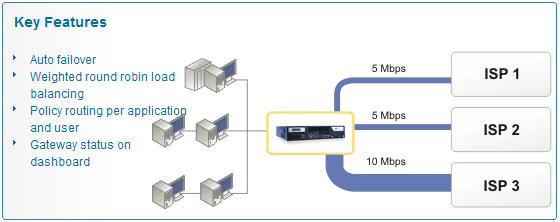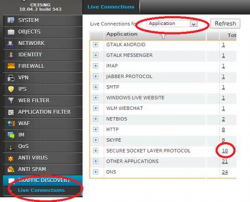Multiple Link Load Balancing and Gateway Failover
Single ISP links can leave business-critical applications of enterprises vulnerable to link failures, resulting in severe business losses. Redundancy in ISP links has become critical for business continuity and greater profitability of enterprises.
Cyberoam Multiple Link Manager enables enterprises to control traffic over multiple WAN links by delivering comprehensive traffic management capability and optimizing the links. It offers high-speed connectivity while maximizing ROI, making optimal use of low-cost, small pipes in combination with high cost links.
A single Cyberoam UTM firewall appliance handles multiple WAN links, limiting capital expenses as compared to solutions where multiple appliances are required to handle multiple WAN links. In the process, Cyberoam delivers integrated security through a single appliance.

Load Balancing
Cyberoam Multi-Link Manager manages Internet traffic in enterprises by balancing the load over multiple ISP links on a weighted round robin basis in policy-based ratios for users and applications.
Enterprises can assign mission critical application traffic to the high speed link, ensuring guaranteed link speed and availability, delivering high levels of application and service availability. While assigning higher weights to a high-speed link, enterprises can use low-cost pipes to even out the peaks in bandwidth usage, optimizing bandwidth expense.
Gateway Failover
Cyberoam Multiple Link Manager monitors link availability of multiple WAN connections and transfers traffic from a failed link to a working link, delivering dependable, seamless connectivity. It ensures continuous application availability so that mission-critical applications like CRM, VoIP do not suffer, enhancing productivity and reducing maintenance costs.
Reporting and Alerts
Cyberoam alerts the enterprise administrators to failure in the gateway link through the dashboard as well as email notifications, facilitating rapid troubleshooting. Cyberoam reporting offers current and historical reporting that enables administrators to evaluate link capacity and performance. Such comprehensive reporting allows administrators to take informed decisions related to bandwidth planning and purchase.


